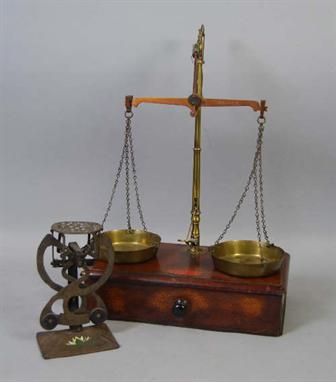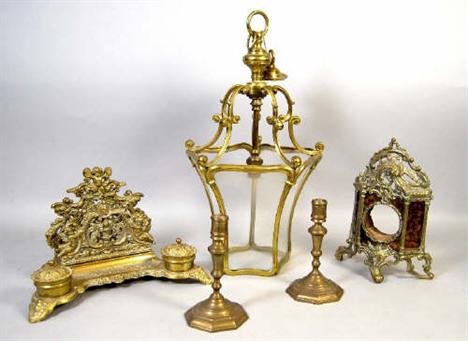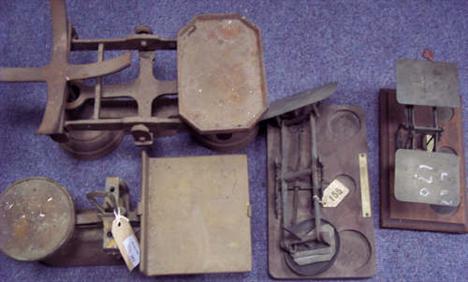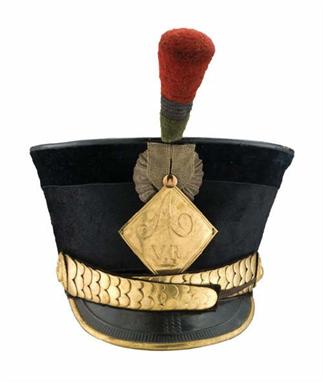We found 63836 price guide item(s) matching your search
There are 63836 lots that match your search criteria. Subscribe now to get instant access to the full price guide service.
Click here to subscribe- List
- Grid
-
63836 item(s)/page
English Numismatic Books, including: Atkins Coins of British Possessions and Colonies 1889, Crowther English Pattern Coins, Henfrey Guide to English Coins 1870, Sheppard and Musham Money Scales and Weights, British Museum Handbook of the Coins of Great Britain 1899, Henfrey English and Scotch Coinage 1885, and sale catalogues
Miniature items. An Army & Navy penknife, with tortoiseshell scales, the blade and hook stamped 'A&N C.S.L,' 1.5in (4cm) l, four smaller penknives, a padlock with key, three ivory Stanhope binocular charms, one with a £20 note dated 3 July 1878, the other two empty, a monocular, empty, and another turned with a photographic view of Interlaken, and a chick emerging from an egg. (12)
An officer's WM cuirass of The Life Guards, breast and backplates with brass edges and studs, leather backed shoulder scales with ornamental ends, gilt lace waiststrap with buckle, red morocco lining with blue velvet borders. Basically GC (heavily tarnished but will respond to careful cleaning) Plate 6
PARTLY FILLED POSTCARD ALBUM OF MAINLY PRE AND IMMEDIATE POST WAR CARDS, mainly greetings and topographical includes real photograph 'The Worlds Smallest Motor Coaches, Madeira Drive, Kemp Town Brighton', Paddle Streamer 'Tattershall Castle, Orient Line S.S. Orsova, T.S.S. Golfito' approx 65 cards together with THREE TRADE PAMPHLETS RELATING TO POOLEY COUNTER AND OTHER SCALES
Property formerly in the collection of Friedrich-Werner Graf von der Schulenburg (1875-1945), Friedrich-Werner Graf von der Schulenburg (1875 -1945) was a diplomat who served as the last German ambassador to the Soviet Union before Operation Barbarossa. He began his diplomatic career before the First World War, serving as consul and ambassador in, amongst others, Lviv, Prague, Warsaw and Tbilisi. At the outbreak of war in 1914 Schulenburg returned to the military, and after the First Battle of the Marne in 1914 he was promoted to captain and put in charge of an artillery battery. In 1915, he went as German liaison officer to the Ottoman Army on the Armenian Front. In 1916, he took over leadership of the Georgian Legion in the struggle with Russia, until its collapse in 1917. He received the Iron Cross and also some high Turkish honours. After the German Empire's collapse, he was captured by the British and interned on the Turkish island of Prinkipo (now called Büyük Ada), returning to Germany only in 1919. Schulenburg returned to the Foreign Office Service and became consul in Beirut and was later envoy to Tehran and Bucharest. In 1934, he was appointed German ambassador to the Soviet Union. He favoured an agreement between Germany and the Soviet Union, and was instrumental in bringing about the August 1939 German-Soviet Non-Aggression Pact. After the Soviet invasion of Poland, despite the state of war between Germany and Poland, he used his position as the senior ambassador in Moscow to allow Polish diplomats to leave Soviet Union. He also tried to thwart the German attack on the Soviet Union in June 1941. After the aggression began Schulenburg was interned for a few weeks, and transferred to the Soviet- Turkish border. Thereafter, Schulenburg was assigned leader of the Russia Committee, a Foreign Office post with no political influence. He was ready and willing to negotiate with Stalin in the plotters' names to overthrow Hitler. After the attempted assassination on Hitler's life in the Stauffenberg conspiracy, or 20th July plot, Schulenberg was arrested, and charged as a 69-year-old with high treason. On 23 October 1944 he was sentenced to death and hung. See also lots 198, 199 and 384, A PERSIAN KARD, 18TH CENTURY, with tapering single-edged blade of watered steel (the tip shortened), chiselled with a slender rib and flowers on the back-edge, the latter enriched with gold, encrusted with gold foliage in a shaped beadwork panel over the forte including a brief inscription on one side, steel hilt comprising chiselled ferrule and back-strap each previously encrusted with gold en suite with the forte (now missing), and a pair of morse grip-scales, in its leather-covered wooden scabbard decorated with red silk and bullion thread, 34.7cm; 13 3/4in
Property formerly in the collection of Friedrich-Werner Graf von der Schulenburg (1875-1945), A CAUCASIAN KINDJAL, LATE 19TH/EARLY 20TH CENTURY, with broad blade cut with a pair of broad diverging fullers on each side, decorated with gold koftgari scrollwork and a brief inscription on the outer face (previously fitted with a paste), steel hilt decorated with gold koftgari, fitted with a pair of horn grip-scales retained by two iron rivets decorated with gold koftgari, in its original leather-covered wooden scabbard with iron suspension band, 56.5cm; 22 1/4in
A CAUCASIAN KINDJAL, LATE 19TH/EARLY 20TH CENTURY, with broad blade cut with an off-set fuller on each side, decorated with gold koftgari scrollwork on each face (losses), steel hilt incorporating a pair of large polished horn grip-scales retained by three iron rivets decorated with gold, in its original fishskin-covered wooden scabbard with iron suspension band decorated with gold koftgari scrolls and provision for accompanying pieces on the reverse, 60.5cm; 23 7/8in
A CAUCASIAN KINDJAL, LATE 19TH/EARLY 20TH CENTURY, with broad blade of watered steel cut with an off-set fuller on each side, decorated with gold koftgari scrollwork inhabited by exotic birds and with the numerals ???, possibly for circa 1909, on one side, and further designs of gold koftgari scrollwork on the other, steel hilt incorporating a pair of large polished horn grip-scales retained by three iron rivets decorated with gold, in its original fishskin-covered wooden scabbard with iron suspension band decorated with gold koftgari, and with an early leather belt, 61cm; 24in
A PERSIAN SHAMSHIR, LATE 17TH/18TH CENTURY, with curved slender single-edged blade of watered steel retaining traces of a gold-inlaid inscription on one side at the forte (areas of light rust), steel hilt comprising a pair of quillons with moulded terminals, back-strap and cap pommel, and a pair of bone grip-scales, in its wooden scabbard covered with tooled leather, large steel chape and a pair of bands with loops for suspension (the scabbard worn), 78cm; 30 3/4in blade
AN INDIAN PESH-KABZ AND AN INDO-PERSIAN JAMIBIYA, 19TH CENTURY, the first with slightly curved reinforced blade decorated with gold flowers and foliage over the forte (losses), steel hilt fitted with a pair of slender fillets and a pair of morse grip-scales over contrasting panels of horn, in its leather-covered wooden scabbard with large silver mounts engraved with foliage; the second with curved fullered blade chiselled with foliage at the forte, morse grip of characteristic form, in a leather-covered wooden scabbard, the first: 35.5cm; 14in, (2)
A RARE FRENCH STEEL HELMET FOR THE EGYPTIAN KHEDIVE'S BODYGUARD, SECOND HALF OF THE 19TH CENTURY, with one-piece skull, fitted with a steel crescent on a conical scalloped brass washer in the centre, moulded brass band around the base, sliding nasal formed as an arrow, and neck-guard with brass rim (worn, throughout, the skull with a small hole, chin scales missing), 28cm 11in high, A more elaborate example is preserved in the Stibbert Museum Florence, inv. no. 16636. See L. G. Boccia 1975, pp. 216-7, no. 783.
THE PROPERTY OF A EUROPEAN NOBLE FAMILY, A TURKISH SILVER-MOUNTED SABRE, SECOND HALF OF THE 17TH CENTURY, with curved single-edged blade double-edged for its last quarter, silver hilt comprising cross-piece engraved with a star divided by tulips, straight quillons with bud-shaped terminals (one terminal missing), back-strap engraved with trellis, and original hardwood grip-scales carved with chevron pattern and retained by three domed silver rivets, in its original leather-covered wooden scabbard, with silver chape engraved with flowers, a pair of engraved brass bands for suspensions, silver locket chiselled with further flowers and foliage (the scabbard mounts with some early working repairs), and the silver parts retaining some original gilding throughout, 80cm; 31 1/2in blade, See footnote to previous lot and E. Petrasch et al 1991, pp. 185-192.
A GERMAN LIGHT CAVALRY GENERAL OFFICER'S MAMELUKE-HILTED SWORD, CIRCA 1815-33, in the Turkish manner, with curved blade double-edged towards the point, steel hilt comprising cross-piece with acorn finials, and a pair of ivory grip-scales rising to form a pierced rounded pommel and shaped for the fingers, in its steel scabbard, 76cm; 30in blade, Provenance, Schloss Cumberland, Gmunden, inv. nos. 1529, 1530, Schloss Marienburg, Hanover, sold Sotheby's October 2005, lot 3690
AN 1834-43 PATTERN 7TH OR PRINCESS ROYAL DRAGOON GUARDS BRASS HELMET, with brass skull fitted with a broad comb decorated with oak foliage, the fore-quarters of a lion at the front and sprays of foliage on each side of the skull, the front applied with brass helmet plate incorporating the full Hanoverian arms and the regimental title beneath, complete with its scalloped chin-scales and leather lining, 33cm; 13in high
A RARE WEST YORKSHIRE DRAGOONS YEOMANRY SHAKO, CIRCA 1819-30, with black leather and beaverskin skull (light wear), applied with silver bullion scrolls around the top, fitted with silver-plated rose-shaped helmet-plate on a circular panel of silver bullion scrolls, silver-plated chin-scales, silver plume-holder with black horsehair plume, complete with its red silk and bullion lines retained by a silvered ring held by silver-plated lion masks (restorations), patent leather peak, and red leather lining band, 26cm; 10 1/4in high, See W. Y. Carman 1970, pp. 79-80.
A CITY OF LONDON IMPERIAL YEOMANRY (ROUGH RIDERS) OFFICER'S LANCE CAP, CIRCA 1910, with leather skull and peak, the upper portion of pale blue baize with gold lace trimmings, silver-plated helmet plate with battle honour for South Africa, gilt-brass fittings including plume-holder, chin-scales suspended from lion mask bosses, cockade applied with the Royal cypher GR, and pale blue swan feather plume, 22.5cm; 8 7/8in high
AN OTHER RANKS 21ST (EMPRESS OF INDIA'S) LANCERS LANCE CAP, CIRCA 1901-10, with leather skull and peak, the upper portion of French grey cloth with yellow trimmings, brass fittings including helmet-plate with Victorian crown and battle honour for Khartoum, plume-holder, and chin-scales suspended from lion mask bosses, cockade applied with ERVII crowned, and white horsehair plume, 22.8cm; 9in high
A CASED HUSSAR OFFICER'S BUSBY, SECOND HALF OF THE 19TH CENTURY, with brown fur body, red bag, silver bullion lines, silver-plated fittings comprising chin-scales suspended from lion mask bosses, plume- holder and red and white feather plume, and the busby and plume each in its original japanned tin case, 18.5cm; 7 1/4in high, (2),
A SWISS INFANTRY JAGER OFFICER'S SHAKO, CIRCA 1830, with black leather skull, applied over the majority if its surface with fine black fur and a band of black velvet at the top, black leather peak with gilt-brass brim, fitted at the front with diamond-shaped gilt-brass helmet plate embossed with the letters 'A' above 'V.R.' silver bullion rosette above, original gilt brass chin-scales with a lion mask boss on each side, the interior retaining much of its tooled and gilt leather lining, and complete with two green and red pom-poms, and a further plain erstaz pom-pom, 19.5cm; 7 5/8in high
A COMPOSITE GERMAN FLUTED FIELD ARMOUR IN THE SO-CALLED MAXIMILIAN FASHION, CIRCA 1515-1530, comprising close helmet formed of a rounded one-piece skull rising to a boldly cabled medial comb and cut away at the nape to receive a neck-guard (missing), bellows visor and bevor attached by later common pivots, the former pierced with a centrally-divided vision-slit and ten horizontal ventilation-slits, the latter formed with a pronounced chin, flanged outwards at the base to form a short front neck-guard, fitted at the right side with a spring-catch to engage the visor and secured to the skull at the right of the neck by a hook and pierced stud, collar of four lames front and rear, the top lames boldly roped, the lowest front plate stamped on the outside with the quality control mark of the city of Nuremberg, and on the inside with the pearled N mark of the same city, globose breastplate struck at the neck with the former mark and pierced at the right of the chest with two later holes for a lance-rest, movable gussets at the arm-openings, waist-lame, and fauld of four lames (the lowest three restored), and tassets each of four lames, matching backplate formed of a main plate (one small hole), fitted with a pair of side plates and a waist-lame flanged outwards to receive a short culet of three lames, the main plate struck at its upper edge with the quality-control mark of the city of Nuremberg, large assymetrical pauldrons (partly restored) each of seven lames overlapping outwards from the third, which bears an haute-piece, articulated vambraces (the right restored) formed of a tubular upper and lower cannons, the former fitted at its upper end with a turner and at the inside of the elbow with a narrow lame, and a couter of three lames, the central lame projecting inwards at the front as a large flat centrally-puckered oval wing, mitten gauntlets each formed of a short straight- ended cuff, four metacarpal-plates, two finger-plates and hinged thumb-defences terminating in a pair of scales (the entire right gauntlet and the finger lames of the left restored), cuisses each formed of a gutter-shaped main plate fitted at its lower edge with a winged poleyn of six lames (the right restored), a pair of tubular full-length greaves each cut with a slot at the heel to accommodate a spur and an arch at the front to accommodate a sabaton of eight lames attached to it by a turning-pin at each side (the right greave and sabaton with patched repairs), the armour decorated throughout with boldly fluted ornament emphasised by pairs of incised lines, and at its main edges with boldly roped inward turns accompanied by recessed borders (areas of pitting and wear throughout): on a wooden stand applied with an early collection label, PROVENANCE, Alphons Meyer, Zürich 1930, The Renne Collection, Constance, The same combination of marks is shown on two Nuremberg armours in the Royal Armouries Leeds, dating to 1510 and 1530 respectively. See A. R. Dufty and W. Reid 1968, pl. XVI and XVII.
A COMPOSITE GERMAN FULL ARMOUR, CIRCA 1500/10, comprising close helmet formed of a rounded one- piece skull rising to a boldly cabled medial comb decorated with pairs of incised lines and cut away at the nape to receive a neck-guard of two lames (later), fitted with brow-reinforce en suite with the skull, visor of 'sparrow's beak' form, pierced with a single stepped vision-slit and a series of circular and slotted ventilation-apertures, fitted at the right with a later lifting-peg, later bevor shaped for the chin and secured to the skull at the right of the neck by a swivel-hook and pierced stud (the skull with an early patched repair), the reinforce, visor and bevor all attached by common pivots, collar of three lames front and rear (the lowest front lame trimmed, pitted, small cracks and chips) the top lames lightly roped, the remainder bordered by single incised lines, strongly formed globose breastplate with a bold inward turn at the neck, fitted with later lance-rest at the right of the chest, movable gussets at the arm- openings (the left restored) en suite with the neck (an early internal patch repair), associated waist-lame, and fauld of three lames with pendant tassets each of four lames (the upper three restored using old plates), backplate formed of a main plate drawn-in at the waist, fitted with waist-lame flanged outwards to receive a short culet of three lames each formed at its upper edge with three cusps, the lowest with a recessed border of low triangular section, a pair of spaudlers each of five lames (the top right restored, small repairs), articulated vambraces formed of tubular upper and lower cannons, the former fitted at its upper end with a turner, and a couter of three lames, the central lame projected inwards at the front as a wing decorated with recessed border, circular besagews (the left restored), each rising to a small central boss and decorated at its edge with roping and a recessed border, gauntlets each formed of a short straight-ended cuff with fixed inner plate, four metacarpal-plates, knuckle-plate (the left restored), shaped finger-plate, hinged thumb-defenses terminating in a pair of scales (the finger-defences restored), and later buff-leather lining gloves, cuisses each formed of a gutter-shaped main plate (the right with a riveted patch) decorated at its upper edge with a bold inward turn and incised lines, and fitted at its lower edge with a winged poleyn of five lames, the wing fluted, and a pair of tubular full-length greaves (both with trimmed edges, the front right plate patched) fitted at the front with a mail sabaton terminating with later steel caps (areas of pitting throughout): on a wooden stand
-
63836 item(s)/page






































